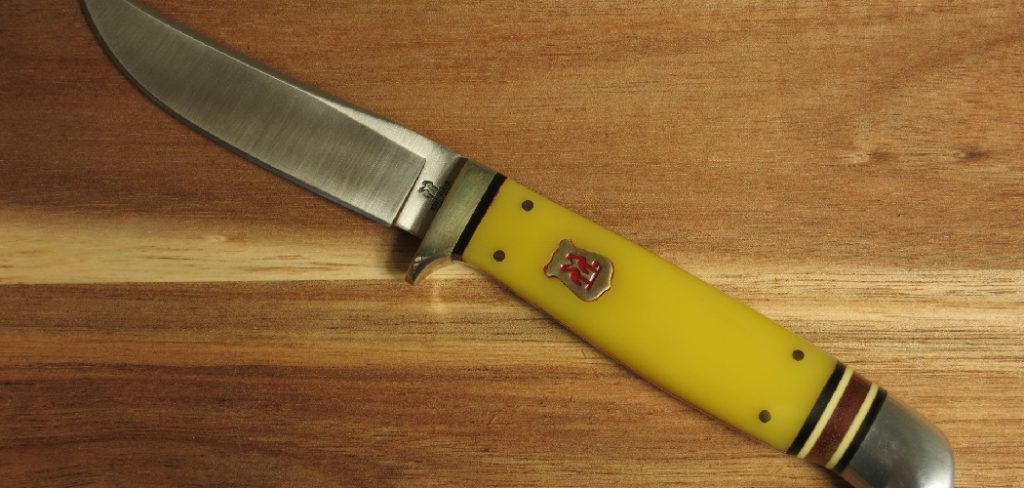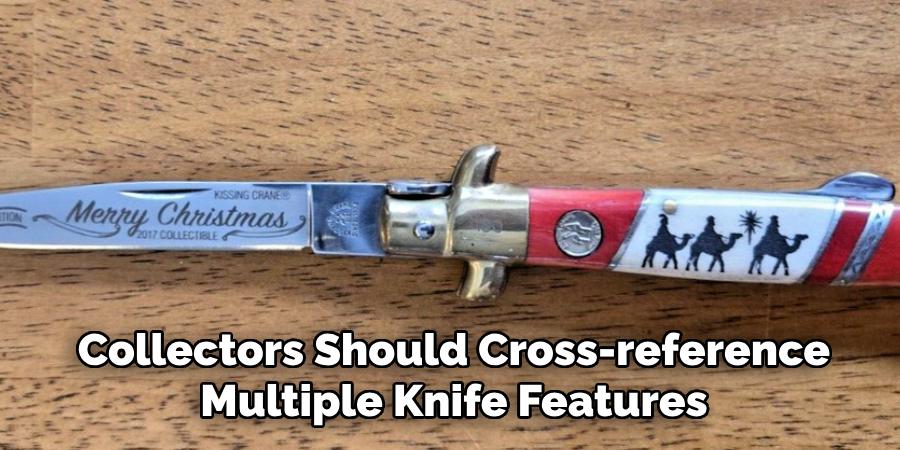Kissing Crane is a prestigious German knife brand that traces its roots back to the 1800s. Renowned for its impeccable craftsmanship and quality, Kissing Crane knives have carved a niche for themselves among collectors and enthusiasts worldwide. Over the decades, these knives have become coveted items, not just for their utility and aesthetics but for their historical value as well. Understanding how to date a Kissing Crane knife is crucial for collectors, historians, and anyone interested in determining the knife’s provenance and value.

This article aims to guide readers through identifying the age of a Kissing Crane knife by examining distinct characteristics such as logos, tang stamps, and manufacturing features. By shedding light on these specifics, readers will know it is necessary to explore and appreciate the storied legacy of Kissing Crane knives.
Overview of Kissing Crane Knife Markings
Kissing Crane Logo
The iconic Kissing Crane logo features two elegantly designed cranes facing one another with their beaks intertwined in a symbolic embrace. This distinct design is not only emblematic of the brand’s identity but also serves as a key indicator of a knife’s vintage. Over the years, the logo has undergone subtle changes, ranging from variations in the intricacy of the crane illustration to differences in the incorporation of additional elements like a border or text beneath the cranes. These modifications can offer insights into the specific era during which a knife was produced, helping collectors to accurately date and authenticate their pieces.
Stamped Markings
Tang stamps on Kissing Crane knives provide another valuable clue for dating these collectibles. Typical markings include the words “Kissing Crane,” “Rostfrei” (indicating rust-free or stainless steel), or “Germany” to signify its origin. The evolution of these tang stamps reflects shifts in manufacturing techniques and branding strategies. Early stamps often feature simple scripts or block letters, whereas later versions might display more stylized fonts or additional information about the blade’s place of manufacture. Analyzing these aspects of stamped markings enables collectors to trace the historical development of Kissing Crane knives across different production periods.
How to Date a Kissing Crane Knife: Examining the Tang Stamps
Pre-1900 Stamps
Kissing Crane knives from before 1900 are distinguished by their simpler tang stamp designs, which often feature handmade engravings. These early stamps typically exhibit a minimalist approach, with straightforward lettering that reflects the era’s craftsmanship. Due to their age, knives bearing these pre-1900 tang stamps are quite rare and thus hold significant historical value. Collectors highly prize these pieces as they provide insight into the early history of knife manufacturing and the particular techniques employed during that time. The scarcity and antiquity of these knives make them invaluable artifacts in the world of knife collecting.
20th-Century Stamps
With the advent of the 20th century, Kissing Crane knives experienced notable shifts in tang stamp designs, marking a transition to more standardized, mass-produced stamps. During this period, the name “Solingen” often appeared on the stamps, signifying the German city renowned for its blade-making excellence. This helped to authenticate the blades’ origins and emphasize their quality. Post-WWII, the tang stamps underwent further changes, with designs leaning towards an export-focused outlook to appeal to international markets. These stamps became more elaborate, incorporating additional informational elements to suit a global audience and reflect the evolving branding strategies of the time.

How to Date a Kissing Crane Knife: Identifying Manufacturing Eras by Features
Pre-1950s Knives
Kissing Crane knives produced before the 1950s are characterized by their use of high-carbon steel blades, which were favored for their sharpness and durability. The handles of these knives often feature natural materials such as bone or wood, demonstrating the artisanal skills prevalent during this era. Unique craftsmanship details are evident in the intricate hand-finished parts and personalized touches that differentiate these early knives. The combination of high-quality materials and meticulous craftsmanship reflects the bespoke nature of knife production during this time, making pre-1950s Kissing Crane knives highly desirable to collectors seeking authenticity and historical significance.
Post-1950s Knives
The post-1950s era shifted towards more modern production techniques in Kissing Crane knives. This period saw the introduction of stainless steel, known as “Rostfrei,” which became the preferred blade material due to its corrosion resistance and low maintenance. Handles during this era transitioned to synthetic materials, like micarta or celluloid, aligning with evolving preferences for durability and innovative design. This era also witnessed the adoption of standardized production methods, allowing for more consistency in knife construction. The shift towards streamlined manufacturing processes gave rise to modern designs, catering to a broader audience and marking a significant evolution in the brand’s storied history.
Understanding Serial Numbers and Limited Editions
Serial Numbers
For many Kissing Crane knife models, serial numbers serve as a crucial identifying feature. Typically found on the knife’s blade or handle, these numbers provide a means to trace production details such as the year or batch in which a knife was manufactured. Decoding these serial numbers requires familiarity with Kissing Crane’s numbering convention, which can vary across different eras and models. Understanding this system is essential for collectors who wish to verify a piece’s authenticity and place it accurately within the timeline of the brand’s production history.
Limited-Edition Models
Kissing Crane has produced various limited-edition models, celebrating significant anniversaries or catering to the collector’s market. These special releases often feature unique identifiers, such as engraved dates or commemorative logos, highlighting their exclusivity and collectible nature. Limited-edition knives may also incorporate premium materials or distinct design elements not found in standard production models, further enhancing their appeal. Collectors value these limited editions for their rarity and ability to convey a piece of Kissing Crane’s rich history, making them treasured artifacts in any collection.

Consulting Resources for Knife Dating
Catalogs and Historical Records
Using archived catalogs or historical advertisements can be an effective method for matching specific features with production years when dating Kissing Crane knives. These documents offer detailed descriptions and visual references that can help identify and verify a knife’s age. Online forums and collector groups also serve as invaluable resources, enabling enthusiasts to exchange information, share discoveries, and gain insights from individuals with extensive knowledge about knife manufacturing history.
Expert Appraisal
Sometimes, consulting a knife expert or professional appraiser becomes necessary to ensure more accurate dating. Experts can offer detailed evaluations and verify a knife’s authenticity, assisting collectors in confirming the age and originality of their pieces. Engaging professional services for appraisal can provide in-depth insights into the knife’s history, unique features, and potential value, thus enhancing the overall understanding and appreciation of a collector’s prized possessions.
Common Pitfalls in Dating Kissing Crane Knives
Reproduction Knives
One frequent challenge collectors face is differentiating authentic Kissing Crane knives from reproductions. These replicas often exhibit mismatched tang stamps that do not align with the known timeline of stamp designs, poor craftsmanship evident in sloppy details, or incorrect materials that do not match historical norms. To verify authenticity, collectors are advised to conduct a detailed inspection, scrutinizing the knife’s design elements, materials, and construction quality to ensure they correspond with authentic Kissing Crane characteristics.
Misleading Markings
Markings added during refurbishing or repair work can complicate dating Kissing Crane knives. Such modifications may introduce elements that confuse the original dating efforts, leading to misidentification. To mitigate these risks, collectors should cross-reference multiple knife features, such as serial numbers, materials, and design elements, and compare them with historical records. This comprehensive approach helps to accurately identify the knife’s production era and authenticity.

Preservation Tips for Vintage Kissing Crane Knives
Proper Cleaning and Storage
To clean vintage Kissing Crane knives without reducing their value, use a soft cloth and mild soap to gently remove dirt and grime. Avoid abrasive cleaners or steel wool, which can scratch the blade. After cleaning, thoroughly dry the knife to prevent rust. Store knives in a low-humidity environment, ideally wrapped in a soft, oil-free cloth, to protect the handles from deterioration and ensure the longevity of these precious collectibles.
Displaying Collectible Knives
When displaying vintage Kissing Crane knives, protecting them from environmental damage, such as moisture and direct sunlight, can lead to fading and rust. Use a display case with UV-protective glass and control humidity levels to maintain optimal conditions. Ensure that knives are securely mounted to prevent accidental drops, allowing them to be admired safely while preserving their condition and historical significance.

Conclusion
Understanding “how to date a Kissing Crane knife” involves a meticulous process, beginning with the examination of logos and tang stamps to identify production eras. Researching historical details through catalogs and expert appraisals for accurate dating is equally important. These steps establish authenticity and underscore the importance of preserving these knives as cherished artifacts in knife-making history. As custodians of these pieces, collectors are encouraged to delve deeper into the rich legacy and craftsmanship Kissing Crane knives represent, ensuring they remain a vibrant part of cultural heritage for future generations.
Edmund Sumlin is a skilled author for Metal Fixes, bringing 6 years of expertise in crafting a wide range of metal fixtures. With a strong background in metalwork, Edmund’s knowledge spans various types of fixtures, from decorative pieces to functional hardware, blending precision with creativity. His passion for metalworking and design has made him a trusted resource in the industry.
Professional Focus:
- Expert in Metal Fixtures : Edmund aesthetic specializes in creating durable and innovative metal fixtures, offering both appeal and functionality. His work reflects a deep understanding of metalworking techniques and materials.
- Sustainability Advocate : He is dedicated to using sustainable practices, ensuring that every fixture is crafted with eco-friendly methods while maintaining high-quality standards.
In his writing for Metal Fixes, Edmund provides valuable insights into the latest trends, techniques, and practical advice for those passionate about metal fixtures, whether they are professionals or DIY enthusiasts. His focus on combining artistry with engineering helps others discover the true potential of metal in design.


